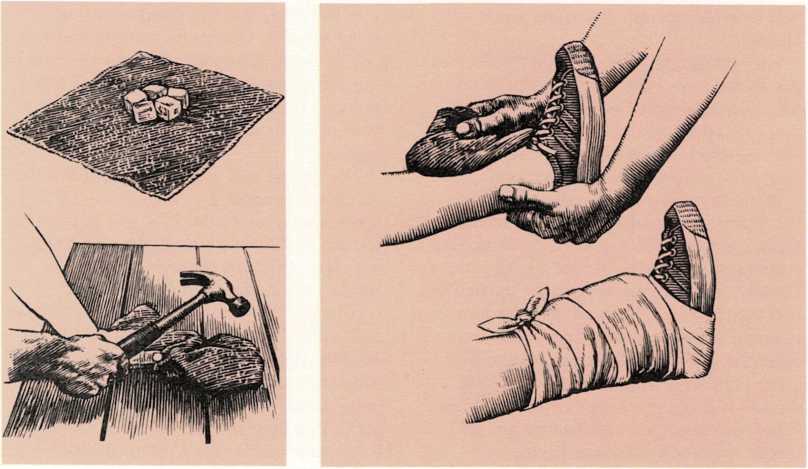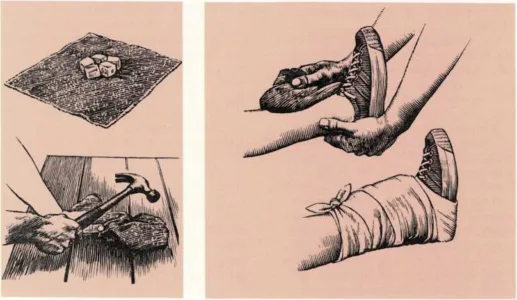Splinters – Stomachache
First aid for sprains

Wrap some ice in a cloth and crush the ice with a hammer. Elevate
the sprained limb and apply the ice pack. Then wrap the cloth around
the ankle to hold the ice pack in place. Leave the child’s shoe on to
prevent swelling.
Splinters usually penetrate the upper layer of the skin only and lie
embedded there. But they can be very painful and annoying because they
press on nerves underneath.
A splinter is usually easy to remove. First, wash the area around the
splinter with warm water and soap. This cleanses and softens the skin
and makes the splinter easier to remove. Sterilize a sharp needle or a
pair of tweezers either with alcohol or by passing the needle or
tweezers through a flame. Then, pick out the splinter. The tweezers will
probably be less upsetting to the child, but sometimes they are not
effective in catching hold of the splinter. You may have to ease the
splinter up with a needle and then pull it out with the tweezers. A
school-age child may be able to remove the splinter without help.
After the splinter is removed, swab the area with alcohol and apply a
sterile dressing. If inflammation begins, if the splinter has not been
completely removed, or if the splinter is deeply embedded, consult the
child’s doctor, [t.m.h.]
Sprain and strain. The term sprain refers to a joint injury; the
term strain refers to a tendon or muscle injury.
A sprain is the stretching of ligaments (the tough bands of fiber that
connect joints) or the stretching of the tissue around a joint (the
capsule). Sprains may occur with or without fracture of the bone.
Sprains may occur in any joint, but are most common in the ankle, wrist,
knee, and fingers. They may result from a strong, sudden wrench or from
jumping or falling. They occur frequently from basketball, hockey, and
other athletic competition.
A sprain usually causes a rather rapid swelling because fluid (and
sometimes blood) accumulates in the tissues around the injured joint.
The area may also appear bruised. There is pain, especially when the
child tries to use the injured part.
Immediate first-aid measures for a sprain include splinting the injured
part if possible, elevating and resting the injured limb, and applying
cold water or, if available, ice. This treatment reduces swelling. If
the sprain
involves the ankle, leave the child’s shoe on. Call a doctor and take
the child to the hospital for X rays to find out whether or not a bone
has been broken and to get proper treatment for the sprain. Your doctor
may wrap the joint with an elastic bandage to provide support or may
apply a plaster splint or cast. Heat, massage, and hydrotherapy
(specialized treatment using water) may be necessary following some
sprains.
Strain refers to a stretching injury of a tendon or a stretching and
tearing injury of a muscle. When a muscle or tendon has undergone
unusual stress, there may be soreness and tenderness to the touch, but
without the damage to tissues that may occur in sprains or fractures. As
a rule, all that a mild strain requires is rest of the muscles or
tendons involved and, perhaps, the application of heat or warmth for
comfort. If pain is intense and persistent, consult the child’s doctor,
[jj.g.]
See also Broken bones; Charley horse; Dislocation of joint
Stammering. See Stuttering
Steaming. See Humidifying
Sterilizing means destroying all germs. Disinfecting means
destroying only disease germs or other harmful microorganisms.
Sterilizing baby’s formula. Most sterilizing begins with the baby’s
formula or with bottles and nipples for baby’s juice. Formula equipment
and formula can be sterilized in two ways. In the first method, the
equipment— bottles, nipples, caps, measuring utensils—and the
formula ingredients are sterilized separately. Then, the formula is
mixed and poured into the bottles. This method is also used to sterilize
the water babies drink. Water is boiled for three minutes and then
poured into bottles that have been boiled previously.
In the second method of sterilizing formula, the formula and the
bottles, caps, and nipples are sterilized together. The formula is mixed
and poured into the bottles, the nipples placed on, and the caps screwed
on
loosely. Then the bottles are boiled, formula and all.
Other needs for destroying germs. In every home, there occasionally
will be other reasons to kill germs by sterilizing or disinfecting.
Different methods are used. You can use heat, chemical germicides, or
soap and water:
You can sterilize a needle that will be used to probe for a splinter
by putting the point of the needle directly into a flame.You can sterilize some liquids, including water and milk, by boiling
them for 5 to 10 minutes.You can disinfect diapers by hanging them out to dry in the sun or
by ironing them.You can disinfect cloth or gauze for bandaging by ironing it.
Hands can be disinfected by cleansing with soap for 3 to 10 minutes,
or by being dipped in germicidal solutions.You can usually disinfect a thermometer by washing it with soap and
cool water.Wounds can be disinfected with soap and water or with medicines made
for this purpose, and can be safeguarded by having sterile dressings
applied by a person with freshly washed hands, [m.g.]
otingS. See Bites and stings
Stomachache is a common complaint of children, but discovering the
exact cause of the stomachache is often not simple. Many times, a
stomachache is a passing complaint of little consequence. In other
cases, it indicates a serious disorder.
If your child has a severe, persistent, or recurrent stomachache, call
your doctor. Never give food, drink, laxatives, or cathartics to a child
with a sudden attack of abdominal pain.
The following are some of the causes of stomachache:
Appendicitis may cause a stomachache that is first felt throughout
the child’s abdomen. In a few hours, the pain moves to the right
lower abdomen. The child may also become nauseated and vomit.Influenza (flu) may cause a stomachache with vomiting and diarrhea.
Colds, sore throats, and earaches are sometimes accompanied by
abdominal pain that is caused by swollen lymph glands in the
abdomen.Food poisoning usually causes nausea, vomiting, and stomachache.
Constipation can cause cramping abdominal pain.
Eating too much food or eating an irritating food may cause
stomachaches.Emotional disturbances or stresses are common causes of recurrent
abdominal pain. This is most common in children who are 9 or 10. The
child may be concerned about such problems as a parent’s illness, a
recent death, or school difficulties, [m.g.]
See also Appendicitis; Colds: Colic; Colitis; Constipation;
Earaches; Food poisoning; Influenza; Sore throat; Swollen glands
Strabismus. See Cross-eye
Strain. See Sprain and strain
Strawberry mark. See **Birthmark

